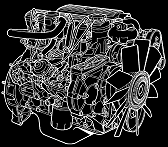The 300Tdi Engine

- Years produced: 1994 - 2006
- Power: 111 bhp (83 kW)
- Torque: 195 lb/ft (264 N/m)
- Fuel: Diesel
- Capacity: 2495cc (2.5 litres)
- Cylinders: 4
- Serial code prefix:
- 16L (non EGR), 23L (EGR), 24L (EGR Auto) Defender
- 17L/18L (EDC Manual), 19L/20L (EDC Auto), 21L (EGR Manual), 22L (EGR Auto) Discovery/Range Rover Classic
The Land Rover 300Tdi engine was an evolution upon the earlier 200Tdi with many improvements and refinements for better on road performance. However, it has the same capacity and power as its predecessor and slightly worse fuel consumption, which has lead some people to downgrade to the 200Tdi given the option. The early 300Tdis had premature timing belt failures resulting in catastrophic engine damage. Land Rover issued a repair kit which could easily rectify issues with guide pulley misalignment.
Land Rover continued to make the 300Tdi alongside for the export market as 'Rest of the World' spec, where EU regulations were not applicable, and for the British Army who deemed the Electronic control unable to guarantee protection against Electromagnetic Pulse (EMP) weapons.
Since the 300Tdi engine is longer than the 200Tdi, the engine was moved further forward in the bay, requiring different engine mounts.
300Tdi service kit
Check out this list of items that are what is required as a "service kit" for the 300Tdi.
EGR and EDC
Some Tdis (engine serial prefix 23L) had Exhaust Recirculation Regulators (EGRs), or Electronic Diesel Control (EDC) which limits the "mechanical only" nature of these pre-Td5 engines. Which engines had these features seems to be unrelated to their year built, but you can tell from the VIN number. The character after the body type shows the type of engine, e.g. SALLDHMF - 110 SW 200Tdi/300Tdi without EDC/Cat or SALLDHA6 110 Hardtop 200Tdi/300Tdi with EDC/Cat. The last character, F or 6 refers to the type of engine in the Land Rover.
The EGR recirculates Nitrous oxides into the engine inlet to be reburnt, which lowers the intake air temperature and improves efficiency, and also burns more of the oxides resulting in "cleaner" exhaust emissions. However, over time they can become clogged with exhaust soot and impair performance, so many owners of older vehicles remove the system entirely.
The EDC engine has a different fuel injection pump which connects to the accelerator through an electronic signal as opposed to the standard steel cable. It is more common on the Discovery 300Tdi.
Converting to the 300Tdi Engine
- From 2.5NA with LT77: Replace the 300Tdi engine back plate with the one from the 2.5 NA and use the LT77 Bell Housing
Converting from the 300Tdi Engine
- To 200Tdi
- To 2.8TGV. This is an engine from MWM International, which improves upon the 300Tdi design
Compatible Gearboxes
Has the R380 as standard but also fits the LT77 by changing the engine back plate to a 2.5NA model and using the LT77 Bell housing, or by removing a single stud from the engine and using the LT77 Bell housing.
Problems
- The 300Tdi can suffer from problems relating to low coolant. Fitting a low coolant alarm can solve this
- Head gasket issues can become apparant around 150k miles
- Early engines had timing belt misaligment issues. All vehicles should have been retrofitted with a kit by 2000